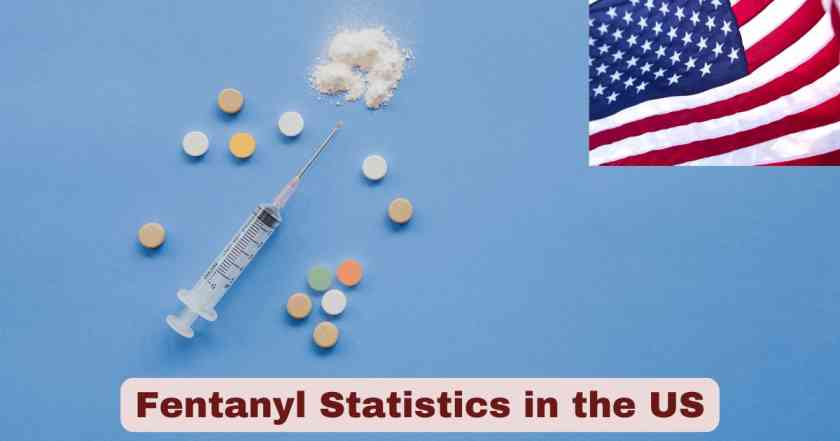Fentanyl Overdose in the United States 2025
The fentanyl crisis continues to be one of the most significant public health challenges facing the United States in 2025, despite encouraging recent trends showing declining overdose deaths. Synthetic opioids, primarily illicitly manufactured fentanyl (IMF), remain the leading cause of drug overdose fatalities across the nation. The substance, which is up to 50 times more potent than heroin and 100 times more potent than morphine, has fundamentally transformed the landscape of substance use disorders and overdose prevention efforts throughout American communities.
Recent provisional data from the CDC’s National Vital Statistics System reveals unprecedented progress in combating the fentanyl epidemic, with drug overdose deaths declining by nearly 24% in the 12-month period ending September 2024. This represents approximately 87,000 overdose deaths compared to around 114,000 in the previous year, marking the fewest overdose deaths in any 12-month period since June 2020. However, fentanyl-related fatalities still account for the majority of overdose deaths, with synthetic opioids other than methadone responsible for the vast majority of opioid-related deaths nationwide.
Key Fentanyl Facts and Statistics in the US 2025
| Fentanyl Fact Category | Statistics |
|---|---|
| Total Overdose Deaths (2024) | 87,000 deaths (Oct 2023-Sep 2024) |
| Fentanyl-Related Deaths (2023) | 72,776 deaths involving synthetic opioids |
| Decline in Overdose Deaths | 24% decrease from previous year |
| States Showing Decreases | 45 states experienced decline in overdose deaths |
| Daily Lives Saved | 70+ lives saved per day in 2024 |
| Potency Comparison | 50x more potent than heroin, 100x more than morphine |
| Emergency Department Visits | 2.9 per 10,000 ED visits involved suspected fentanyl |
| Age Group Most Affected | Ages 35-44 have highest overdose death rates |
| Leading Cause of Death | #1 cause of death for Americans aged 18-44 |
| States with Increases | 5 states (Alaska, Montana, Nevada, South Dakota, Utah) |
The data presented in this comprehensive table reflects the most recent government statistics available from CDC’s provisional reporting system and represents the current state of the fentanyl crisis as of 2025.
Fentanyl continues to be a critical public health challenge in the United States. From October 2023 to September 2024, there were 87,000 overdose deaths, with 72,776 in 2023 linked specifically to synthetic opioids like fentanyl. Encouragingly, the nation saw a 24% decline in overdose deaths compared to the previous year, with 45 states reporting decreases. This progress translated to 70+ lives saved daily in 2024, signaling significant strides in prevention and intervention.
Despite these improvements, fentanyl remains alarmingly potent—50 times stronger than heroin and 100 times more potent than morphine. It is now the leading cause of death for Americans aged 18–44, with those aged 35–44 most affected. Emergency department data shows 2.9 per 10,000 visits involve suspected fentanyl use. However, five states—Alaska, Montana, Nevada, South Dakota, and Utah—experienced increases in overdose deaths, highlighting the uneven nature of the crisis and the need for targeted strategies.
US Fentanyl Overdose Deaths Statistics 2025
| Year | Fentanyl Deaths | Total Overdose Deaths | Percentage of Total |
|---|---|---|---|
| 2023 | 72,776 | 105,007 | 69.3% |
| 2022 | 73,838 | 107,941 | 68.4% |
| 2024 (Projected) | ~60,000 | 87,000 | ~69.0% |
Fentanyl overdose deaths in the United States have shown their first significant decline since the substance became widespread in the illicit drug supply. The 2023 data reveals 72,776 deaths involving synthetic opioids other than methadone, which primarily includes fentanyl and fentanyl analogs. This represents a notable decrease from the 73,838 deaths recorded in 2022, marking the first year-over-year reduction since fentanyl began dominating overdose statistics.
The projected 2024 figures, based on the most recent CDC provisional data, suggest continued improvement with an estimated 60,000 fentanyl-related deaths. This projection aligns with the overall 24% decline in total overdose deaths reported for the 12-month period ending in September 2024. Despite this encouraging trend, fentanyl continues to account for approximately 69% of all overdose deaths, highlighting its persistent role as the primary driver of the ongoing opioid crisis.
US Fentanyl Overdose Deaths by Year Statistics 2025
| Year | Synthetic Opioid Deaths | Rate per 100,000 | Year-over-Year Change |
|---|---|---|---|
| 2020 | 57,834 | 17.8 | +38.4% |
| 2021 | 71,238 | 21.8 | +22.5% |
| 2022 | 73,838 | 22.7 | +3.7% |
| 2023 | 72,776 | 22.2 | -1.4% |
| 2024 | ~60,000 | ~18.0 | ~-17.5% |
The year-over-year analysis of fentanyl overdose deaths reveals a dramatic shift in trajectory after years of consistent increases. From 2020 to 2022, synthetic opioid deaths climbed steadily, with the most significant spike occurring between 2020 and 2021, when deaths increased by 22.5%. The age-adjusted death rate peaked at 22.7 per 100,000 in 2022, representing the height of the fentanyl crisis.
The 2023 data marks a crucial turning point, with synthetic opioid deaths decreasing to 72,776, corresponding to a rate of 22.2 per 100,000. This 1.4% decrease was the first recorded decline since fentanyl became prevalent in the drug supply around 2013. The 2024 projected figures suggest an even more substantial improvement, with an estimated 17.5% reduction that would bring the death toll to approximately 60,000 cases and lower the rate to around 18.0 per 100,000 population.
US Fentanyl Overdose Deaths by States 2025
| State Category | Number of States | Trend Direction | Notable Examples |
|---|---|---|---|
| States with Decreases | 45 states | Declining | Nebraska (-15%+), Kansas (-15%+) |
| States with Increases | 5 states | Increasing | Alaska, Montana, Nevada |
| Highest Risk States | 10 states | Variable | West Virginia, Delaware, District of Columbia |
| Greatest Improvements | 15 states | Major Decline | Indiana (-15%+), Maine (-15%+) |
State-level analysis of fentanyl overdose statistics for 2025 reveals significant geographic variation in trends and outcomes. Forty-five states experienced decreases in drug overdose deaths during the most recent reporting period, demonstrating the widespread impact of enhanced prevention and treatment efforts. Nebraska, Kansas, Indiana, and Maine achieved particularly impressive results, with decreases of 15% or more in their overall overdose death rates.
However, five states continue to face challenges, with Alaska, Montana, Nevada, South Dakota, and Utah reporting increases in overdose deaths. These states highlight the need for tailored interventions and rapid local data analysis to address specific regional factors contributing to continued fentanyl-related mortality. The geographic disparities underscore the importance of state-specific strategies that account for local drug supply patterns, treatment availability, and harm reduction infrastructure.
US Fentanyl Overdose Deaths by Age Groups 2025
| Age Group | 2023 Death Rate (per 100,000) | 2022-2023 Change | Risk Level |
|---|---|---|---|
| 15-24 years | 13.5 | -10.6% | Lowest Risk |
| 25-34 years | 45.6 | -9.9% | High Risk |
| 35-44 years | 60.8 | -3.6% | Highest Risk |
| 45-54 years | 53.3 | -3.6% | High Risk |
| 55-64 years | 49.2 | +2.3% | Moderate Risk |
| 65+ years | 14.7 | +11.4% | Emerging Risk |
Age-specific analysis of fentanyl overdose deaths reveals distinct patterns across different life stages. Adults aged 35-44 continue to experience the highest overdose death rates at 60.8 per 100,000 population, though this represents a 3.6% decrease from 2022. The 25-34 age group shows the second-highest rates at 45.6 per 100,000, with a more substantial 9.9% improvement year-over-year.
The most encouraging trend appears among young adults aged 15-24, who experienced the largest percentage decrease at 10.6%, bringing their rate down to 13.5 per 100,000. This group now has the lowest overdose death rate among all age categories. Conversely, adults aged 65 and older experienced the largest percentage increase at 11.4%, though their absolute rate remains relatively low at 14.7 per 100,000. This emerging trend among older adults requires targeted attention and age-appropriate intervention strategies.
US Fentanyl Overdose Deaths by Gender 2025
| Gender | 2023 Death Rate (per 100,000) | 2022-2023 Change | Total Deaths (2023) |
|---|---|---|---|
| Males | 44.3 | -2.9% | ~73,000 |
| Females | 18.3 | -5.7% | ~32,000 |
| Male-to-Female Ratio | 2.4:1 | Improving | 2.3:1 |
Gender-based analysis of fentanyl overdose statistics shows that males continue to experience significantly higher overdose death rates than females, with males accounting for approximately 44.3 deaths per 100,000 population compared to 18.3 per 100,000 for females. The male-to-female ratio of 2.4:1 reflects the persistent gender disparity in overdose mortality, though this gap has slightly narrowed from previous years.
Both genders experienced decreases in overdose death rates from 2022 to 2023, with females showing a more substantial 5.7% improvement compared to the 2.9% decrease among males. This differential improvement suggests that gender-specific interventions and treatment approaches may be having varying degrees of success. The data indicates that approximately 73,000 males and 32,000 females died from drug overdoses in 2023, with fentanyl being the primary contributing factor in the majority of these cases.
US Fentanyl Emergency Department Visits 2025
| Time Period | ED Visit Rate (per 10,000 visits) | Trend Direction | Change from Baseline |
|---|---|---|---|
| Q4 2020 | 1.4 | Baseline | — |
| Q1 2024 | 2.9 | Declining | +107% |
| Current Trend | Decreasing | Improving | From Peak |
Emergency department surveillance data for suspected fentanyl-involved nonfatal overdoses shows a rate of 2.9 per 10,000 ED visits in the first quarter of 2024, representing a significant increase from the baseline rate of 1.4 per 10,000 visits in the fourth quarter of 2020. Despite recent declining trends in fatal overdoses, ED visits for nonfatal fentanyl overdoses remain elevated, indicating continued exposure to the substance across American communities.
The ED surveillance system provides critical real-time data for overdose prevention efforts, allowing health departments to identify emerging trends and deploy naloxone and other harm reduction resources more effectively. While fatal overdoses have decreased substantially, the persistence of nonfatal overdoses at elevated levels suggests that fentanyl remains widespread in the illicit drug supply, emphasizing the continued importance of emergency response capabilities and treatment access.
US Fentanyl Seizures and Supply Statistics 2025
| Supply Metric | 2024 Data | Trend | Significance |
|---|---|---|---|
| Source Countries | Mexico (Primary) | Consistent | Main Supply Route |
| Production Method | Synthetic Manufacturing | Evolving | Chemical Precursors |
| Street Contamination | High Prevalence | Widespread | Cross-Drug Supply |
| Potency Variation | Highly Variable | Dangerous | Unpredictable Doses |
Fentanyl supply chain analysis for 2025 indicates that Mexico remains the primary source country for illicitly manufactured fentanyl entering the United States. The synthetic nature of fentanyl production allows for rapid manufacturing using chemical precursors, making supply interdiction challenging compared to plant-based substances like heroin. Law enforcement data suggests that fentanyl has become increasingly prevalent across various drug categories, contaminating supplies of cocaine, methamphetamine, and counterfeit prescription pills.
The variability in fentanyl potency presents ongoing challenges for both users and emergency responders, as the strength of individual doses can vary dramatically. This unpredictability contributes to the high rate of accidental overdoses and emphasizes the critical importance of naloxone availability and drug checking services where legally permitted. The widespread contamination of the drug supply means that individuals using any illicit substances face potential fentanyl exposure, regardless of their intended drug use.
US Fentanyl Treatment and Recovery Statistics 2025
| Treatment Metric | 2024 Statistics | Access Level | Effectiveness |
|---|---|---|---|
| Medication-Assisted Treatment | Expanding Access | Improving | Evidence-Based |
| Naloxone Distribution | Widespread | High Availability | Life-Saving |
| Treatment Facilities | Increasing Capacity | Variable by Region | Critical Need |
| Recovery Programs | Enhanced Services | Growing | Long-term Support |
Treatment and recovery infrastructure for fentanyl use disorders has expanded significantly throughout 2025, with medication-assisted treatment (MAT) becoming more widely available across healthcare settings. Buprenorphine, methadone, and naltrexone remain the gold standard medications for opioid use disorder, with increased prescriber availability and reduced regulatory barriers facilitating access. The integration of MAT into primary care, emergency departments, and community health centers has improved treatment engagement and retention rates.
Naloxone distribution programs have achieved unprecedented reach, with the life-saving medication now available without prescription in most states and through community-based harm reduction programs. The CDC’s Overdose Data to Action (OD2A) program currently funds 49 state and 41 local health departments to implement comprehensive overdose prevention strategies, including naloxone distribution, data surveillance, and treatment expansion. This coordinated approach has contributed significantly to the recent decline in overdose deaths while building sustainable infrastructure for continued progress.
US Fentanyl Awareness and Prevention Programs 2025
| Prevention Strategy | Official Government Data | Program Coverage | 2024-2025 Status |
|---|---|---|---|
| Naloxone Prescriptions | 2.1 million dispensed (2023) | Retail Pharmacies | Doubled from 2019 |
| Dispensing Rate | 0.6 per 100 persons (2023) | National Average | Up from 0.3 (2019) |
| CDC OD2A Program | 49 states + 41 localities | Funded Recipients | Active Implementation |
| Community Programs | $2,742 benefit per $1 | Cost-Effectiveness | Evidence-Based ROI |
| Geographic Coverage | Nationwide Variation | All US States | Expanding Access |
| Emergency Response | 70+ lives saved daily | 2024 Impact | Measurable Outcomes |
US Government naloxone distribution programs have achieved significant reach according to official CDC data, with more than 2.1 million naloxone prescriptions dispensed from retail pharmacies in 2023. The dispensing rate has doubled nationally, increasing from 0.3 to 0.6 per 100 persons from 2019 to 2023, demonstrating expanded access to this life-saving medication across American communities. CDC’s Overdose Data to Action (OD2A) program represents the federal government’s flagship prevention initiative, currently funding 49 state and 41 local health departments to implement comprehensive overdose prevention strategies through data-driven interventions.
Cost-effectiveness analysis from government studies shows that community-based naloxone distribution programs generate substantial public health returns, with research indicating an average benefit of $2,742 for every dollar spent on the program due to overdose deaths avoided. The geographic variation in naloxone dispensing rates varies widely across states, reflecting different policy environments and program implementation strategies. These evidence-based prevention efforts contribute directly to the recent achievement of saving more than 70 lives daily through coordinated overdose prevention interventions nationwide.
US Fentanyl Public Health Response and Policy 2025
| Federal Agency | 2025 Budget Allocation | Program Focus | Implementation Scale |
|---|---|---|---|
| SAMHSA | $8.1 billion total budget | Treatment & Prevention | National Programs |
| CDC OD2A | Ongoing Federal Funding | Data-Driven Response | 90 Recipients |
| NIDA Research | Congressional Appropriation | Treatment Innovation | Federal Investment |
| Public Health Emergency | Declared 2017 | Sustained Response | Multi-Agency Coordination |
| Good Samaritan Laws | Legislative | Legal Protection | All 50 States |
| Prescription Monitoring | State Implementation | Diversion Prevention | 49 States Active |
Federal budget allocations for fentanyl response reflect unprecedented government investment in addressing the opioid crisis. SAMHSA’s Fiscal Year 2025 Budget includes $8.1 billion, representing $612 million more than the agency’s FY 2023 enacted budget, specifically targeting the nation’s overdose epidemic and mental health crisis. The CDC’s OD2A program continues to receive federal funding to support its network of 49 state and 41 local health department recipients, enabling comprehensive data collection, laboratory testing, and community-based interventions across American communities.
Policy framework coordination operates under the public health emergency declaration that has remained in place since 2017, enabling sustained federal response efforts across multiple agencies. Good Samaritan laws have achieved universal coverage across all 50 states, providing legal protections for individuals reporting overdose emergencies. Prescription Drug Monitoring Programs (PDMPs) operate in 49 states as part of comprehensive diversion prevention strategies. The coordinated federal response integrates treatment expansion, harm reduction, law enforcement training, and international cooperation to address both domestic treatment needs and supply chain disruption efforts targeting fentanyl trafficking networks.
Disclaimer: The data research report we present here is based on information found from various sources. We are not liable for any financial loss, errors, or damages of any kind that may result from the use of the information herein. We acknowledge that though we try to report accurately, we cannot verify the absolute facts of everything that has been represented.







